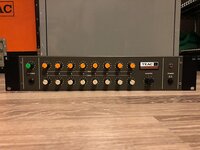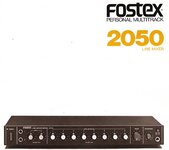Hello, I have been trying out a mint M-30 I got back in December with my A-2340 and I really love it but it's architecture is a little confusing and after reading some old threads and the manual I'm a little lost on how exactly I can record and monitor playback for overdubbing without repatching. I have up until now simplified my recording setup with my decks by using a split console setup on a Mackie CR1604.
Firstly I made a song basically running the M-30 like you would any split console. I had the direct outs feeding the deck channel 1-4 and had my tape returns feeding the line is on channel 5-8 on the M-30. This is what I discovered. So the submix section and the channel faders are both controlling levels into the deck as well as panning, having the submix set to post on all 8 so I can track with EQ and mix the returns with EQ as well. I successfully finished a song that included collapsing tracks (submix output into channel 4) and 3 additional tracks on channel 1-3. Basically I balanced the submix level controls and fine tuned the levels on channel faders 5-8 with EQ on the strips but panning on the submix. It appears the channel pan pots do nothing in my configuration. So let me get to my questions. My apologies I think it's important I highlight what I have figured out so far.
I followed the manuals patching for a 4 track setup using buss outs and tape ins and figured out how to get the assign switches and channel pan pots to feed each channel on the deck as well but after tracking one channel I realized the submix can't playback channel one while I Track to channel 2 on the deck without re patching to channel 2 manually. I've never been able to get this to work on this mixer or my old beat up M-208. I think my major disconnect with these older tascam boards comes from my experience with portastudio cue systems. The system where you can record a track. Monitor it while simply panning channel 1 hard right to track to channel 2 without any repatching. I guess my ultimate question is whether this sort of workflow is possible on the M-30? From all I'm reading it seems it is and that was the whole point of this insanely versatile open ended mixer but it's simply lost on me. Sorry for the long post but I'd like to know what I'm missing.
Firstly I made a song basically running the M-30 like you would any split console. I had the direct outs feeding the deck channel 1-4 and had my tape returns feeding the line is on channel 5-8 on the M-30. This is what I discovered. So the submix section and the channel faders are both controlling levels into the deck as well as panning, having the submix set to post on all 8 so I can track with EQ and mix the returns with EQ as well. I successfully finished a song that included collapsing tracks (submix output into channel 4) and 3 additional tracks on channel 1-3. Basically I balanced the submix level controls and fine tuned the levels on channel faders 5-8 with EQ on the strips but panning on the submix. It appears the channel pan pots do nothing in my configuration. So let me get to my questions. My apologies I think it's important I highlight what I have figured out so far.
I followed the manuals patching for a 4 track setup using buss outs and tape ins and figured out how to get the assign switches and channel pan pots to feed each channel on the deck as well but after tracking one channel I realized the submix can't playback channel one while I Track to channel 2 on the deck without re patching to channel 2 manually. I've never been able to get this to work on this mixer or my old beat up M-208. I think my major disconnect with these older tascam boards comes from my experience with portastudio cue systems. The system where you can record a track. Monitor it while simply panning channel 1 hard right to track to channel 2 without any repatching. I guess my ultimate question is whether this sort of workflow is possible on the M-30? From all I'm reading it seems it is and that was the whole point of this insanely versatile open ended mixer but it's simply lost on me. Sorry for the long post but I'd like to know what I'm missing.


